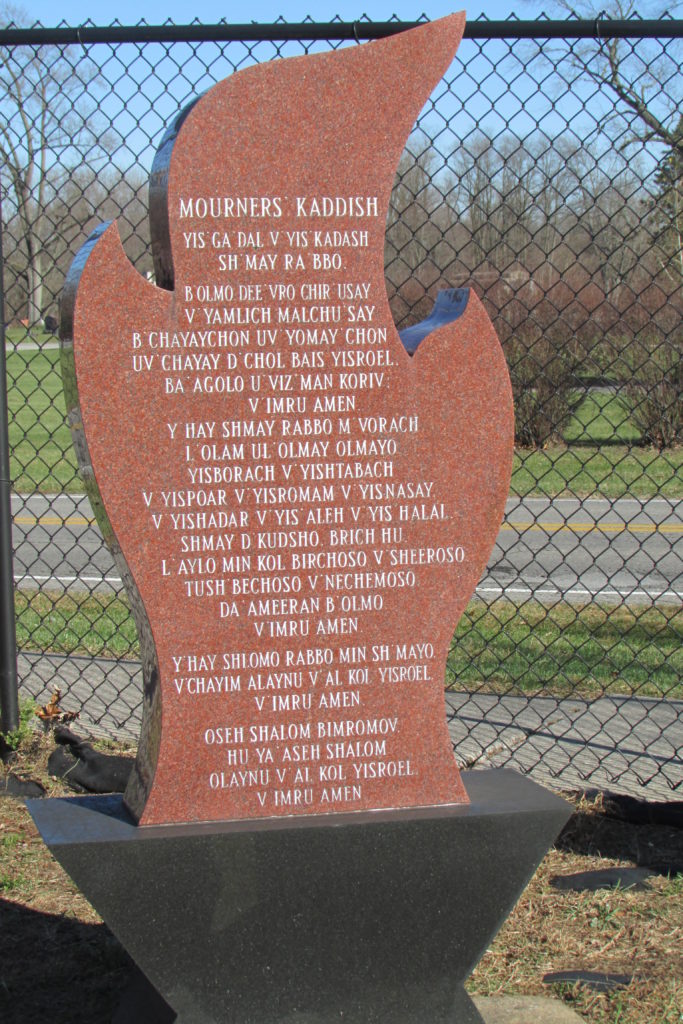עוֹשֶׂה שָׁלוֹם בִּמְרוֹמָיו הוּא יַעֲשֶׂה שָׁלוֹם עָלֵינוּ
Oseh Shalom is a prayer that appears several times throughout Jewish services, including at the end of the recitation of the mourner’s Kaddish, a prayer in memory of loved ones who have died. There are many different arrangements of this prayer to various tunes, including a recent appearance in Come From Away, a musical about the passengers, crew and locals who met on Newfoundland during the grounding of transatlantic flights on September 11, 2001. Oseh Shalom takes many forms, including accompaniment to up-beat traditional dances, as well as slower, more contemplative versions that, nonetheless, all feature roughly the same words: “The one who makes peace in the heights, may They make peace for us, for all Israel [and for all of humanity or for all who dwell on Earth] and let us say Amen.”

Temple Israel Cemetery
This song, even in its most upbeat, danceable form, is still the same prayer recited at the end of the Mourner’s Kaddish. The Mourner’s Kaddish is an important act of ritualized mourning, where one who has recently lost a loved one, or who is recalling an anniversary of that loss, is invited to stand to recite a set prayer surrounded by the congregation. In some denominations, everyone present joins in to recite it as well. The words of the Mourner’s Kaddish do not reflect loss or grief, but rather emphasize the praise of the divine and lead into the prayer for peace.
The phrasing ‘one who brings peace in the heights’ can be found in the Book of Job (25:2). In this context, Bildad the Shuhite, a friend of Job, is attempting to console the man. Bildad is not doing a good job here; he reminds Job of the inherent worthlessness of humanity in the eyes of the divine who can create peace in the heights. Job’s answer to Bildad is valuable for anyone seeking an understanding of creating peace through justice in the context of this particular text. Malbim, a 19th Century rabbi from what is now Ukraine, notes that Bildad’s attempt to console Job strikes Job as disingenuous. True consolation would allow for Job’s grief. True consolation would allow Job to speak the truth of his experiences, allowing him to have an honest relationship with the divine. The one who brings peace in the heavens requires this honesty; lying, flattery or pretending that things are well does both humanity and the Divine a disservice.
The phrasing of “one who brings peace” is recited in the context of a Mourner’s prayer where one says nothing about death or loss but is instead praying for the praise of the Divine. Nonetheless, this prayer can be said with grief and with full feeling, reminiscent of Truth and Reconciliation approaches. This honest expression of loss in a communal setting does not end with more praise of the Divine, but rather with one request: May the one who brings peace in the heights bring peace to all of us here, both the ones who require consoling and those who console. This prayer asks for peace not just for the self or the religious community, but for the wider world. It is a song for joyous occasions and for mournful ones, because peace is vital enough to be in demand at all times.
What Do You Think?
- When a prayer for peace is contextualized by a prayer of mourning, how does it change the way you think about what peace can look like?
- If you seek peace while mourning, do you think of it as a way to remember the dead or seek healing for yourself?
- What do you see as the role of anger or grief in the peace-building process?
- God is described here as one who makes peace. When you think of your own religious traditions, or those of family and friends or the community around you, how are images of the Divine and peace related?
If you enjoyed this item in our museum…
You might also enjoy ‘Make me a Channel of your Peace‘, ‘Om Shanti‘ and other items with the tag ‘Reconciliation‘.
Jenny Oberholtzer, May 2022